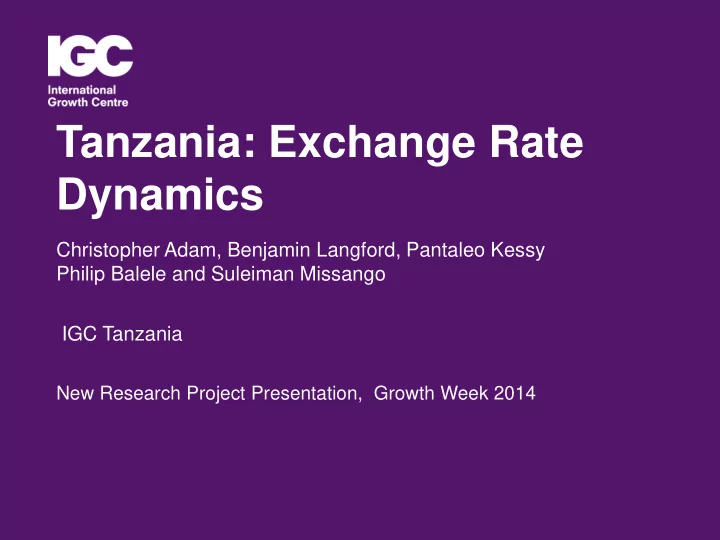

Tanzania: Exchange Rate Dynamics Christopher Adam, Benjamin Langford, Pantaleo Kessy Philip Balele and Suleiman Missango IGC Tanzania New Research Project Presentation, Growth Week 2014
Outline • What’s happening to the exchange rate in Tanzania? • A focus on the capital account and market structure • Looking forward – research approach and possible policy directions • Relevance beyond Tanzania 2
Strong commitment to a floating regime but are we seeing a decisive change in real exchange rate dynamics? Tanzania: Nominal and Real Effective Exchange Rate [increase implies depreciation] .5 1=100%] 0 Equilibrium or misalignment? -.5 2000m1 2005m1 2010m1 2015m1 Log nominal effective exchange rate Log real effective exchange rate 3
An informative episode: post 2011 ‘East African stabilization’ episode, behaviour in IFEM (and money markets) changes. Tanzania: real exchange rate decomposition .6 Capital a/c .4 restrictions 2005m12=0 .2 0 -.2 2005m1 2010m1 2015m1 Price differential nominal exchange rate Tsh/US$ 4
Coordinated stabilization actions by central bank Governors of Kenya, Uganda and Tanzania in October 2011 • BoT tightens rates and: • reduces maximum net open position; • restricts T.Shilling funding to non-resident customers; • closes many derivative channels. 5
Evidence suggests sharp and sustained jump in country risk premium / carry-trade gains… Tanzania: deviation from interest parity Accompanied by: interest differential adjusted for exchange rate movement • Increased interest .3 rate volatility (absolute and 1=100 percent per annum relative to .2 exchange rate) .1 • Increase in banks’ excess liquidity. 0 -.1 2008m1 2010m1 2012m1 2014m1 6
Policy choices and market structure? • What does this episode tell us about the capital account and capital account liberalization in exchange rate determination in Tanzania? • What role market structure (in forex and money markets)? • What role BoT liquidity management / intervention play? • Research approach: ‘conventional’ macro approaches to exchange rate determination combined with high-frequency transaction level data from 2010 to 2014. 7
International Growth Centre London School of Economics and Political Science Houghton Street London WC2 2AE www.theigc.org
Supplementary Slides
So, what does this episode tell us and how do we use this? • Role of Float since 1993, first through auctions then creation of interbank foreign exchange market (IFEM) in mid-2000s. • ‘Two-way’ pricing introduced from 2006. • Government, through BoT, a structural net seller to IFEM for liquidity management purposes. • Policy reforms vs micro-structural characteristics of the market? 10
Coordinated stabilization actions by central bank Governors of Kenya, Uganda and Tanzania in October 2011 EAC Headline Inflation 2010-14 35% Kenya Tanzania Uganda 30% 25% Percent per annum 20% 15% 10% 5% 0% Jan-10 Jul-10 Jan-11 Jul-11 Jan-12 Jul-12 Jan-13 Jul-13 Jan-14 Jul-14 11
Coordinated stabilization actions by central bank Governors of Kenya, Uganda and Tanzania in October 2011 Tanzania: short-run interest rates 30 Percent per annum 20 10 0 2009m7 2010m7 2011m7 2012m7 2013m7 2014m7 Treasury Bill rate Interbank cash market Bank rate 12
…continued volatility in domestic interest rates and a reversal of the trend decline in excess reserves… Commercial Banks' Excess Reserves σ 2 (r)/σ 2 (e) Percent of statutory reserves (= 10% of eligible deposits) .5 2009 75 2010 88 2011 28 .4 2012 177 1=100% .3 2013 125 2014 140 .2 .1 2010m7 2011m7 2012m7 2013m7 2014m7 13
Bank Concentration Ratios 2005 2014 IFEM IFEM RETAIL All Finance CR(3) 53% 39% 38% 55% CR(5) 68% 51% 55% 75% H- Index 12.6% 7.6% 8.1% 14.2% 14
Bank of Tanzania IFEM reaction functions Dependent variable: Δ BoT_net_sales(t) Daily Weekly Monthly [1] [2] [3] [4] [5] [6] Deviation from -0.45*** - -0.08 planned sales(t-1) 0.17** * positive -0.61*** -0.15*** -0.09 negative -0.33** -0.39 0.10 Order flow(t) 0.005 0.001 Interest rate -0.008 -0.006 differential (t) R-square 0.19 0.21 0.07 0.08 0.12 0.13 15
Recommend
More recommend